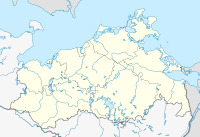Nature reserve dune pine forest on Langhagensee
Coordinates: 53 ° 35 ′ 29.5 ″ N , 12 ° 12 ′ 3.6 ″ E
The nature reserve dune pine forest on the Langhagensee is a 16 hectare nature reserve in Mecklenburg-Western Pomerania on the south bank of the Langhagensee . The closest village is Wooster Teerofen one kilometer to the east. The legal determination took place on June 1, 1972 with an extension in 1996. The nature reserve serves to preserve a light juniper-pine forest formed by grazing on an inland dune in the Wooster Heide.
The state of the area is assessed as good. The grazing necessary to maintain the protection goal continues, supported by the Foundation for Environment and Nature Conservation MV. Furthermore, forest interventions prevent the areas from being forested.
The protected area is located in the Nossentiner-Schwinzer Heide nature park and is part of an FFH and bird protection area under EU law .
A signposted hiking trail allows you to enter the area.
history
The protected area is located on a post-glacial inland dune that stretches around the Langhagensee in a horseshoe shape. A rampart on the east bank of the Langhagensee indicates that the area was settled in the Slav period. The village to the east of Wooster Teerofen was founded in 1705 and goes back to a tar smelling and a tiednery . On Wiebeking's map from 1786, the area can be identified as afforestation with the name Wooster Tannen . The forest area was owned by the Dobbertin Monastery until 1918 . The protected area was characterized by grazing in Hudewald use . The forest workers' families and foresters were allowed to drive cattle into the forest and let them graze unattended. During the GDR era, the pines were resinated to extract turpentine. After grazing was abandoned, it was resumed in 1992. The area is currently grazed every three to five years.
Flora and fauna
The formative pines in the area are up to 160 years old. Sturdy is the stock with birch trees , stalk and sessile oak and beech trees . Juniper pervades the areas in individual groups. Acid-producing plants also occur, such as wire-smear , bilberry , sand-sedge and wood sorrel .
The bat fauna has been intensively examined as part of a monitoring system since 1984. 9755 rough- skin bats and 5018 water bats were counted and 10,000 animals were ringed. Other species are fringed bat , noctule bat and brown long-eared bat .
Particularly noteworthy bird species are the black woodpecker , stock dove and golden eyelid . The otter lives in the area.
literature
- Dune pine forest at Langhagensee 84 . In: Ministry of Environment Mecklenburg-Western Pomerania (Hrsg.): The nature reserves in Mecklenburg-Western Pomerania . Demmler-Verlag, Schwerin 2003, ISBN 3-910150-52-7 , p. 534 f .
Web links
- NSG regulation
- Map portal environment of the State Office for the Environment, Nature Conservation and Geology Mecklenburg-Western Pomerania ( information ) with geodata
Individual evidence
- ↑ Heidepflegefonds - Funded Measures 2007 ( Memento of March 12, 2005 in the Internet Archive )
- ↑ Standard data sheet FFH area Paschen-, Langhagen- and Validzsee (PDF; 57 kB)
- ↑ Standard data sheet for the EU bird sanctuary Nossentiner-Schwinzer Heide
- ↑ Burgwall Sandhof in the KLEKs
- ↑ Wooster tar oven in the KLEKs
- ↑ 15 years of the Nossentiner / Schwinzer Heide Nature Park (PDF)


